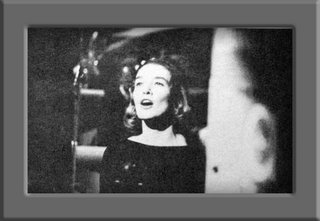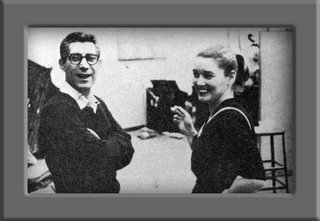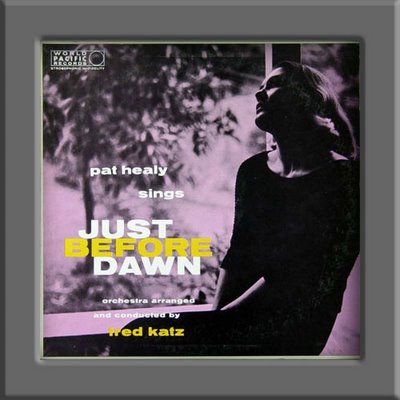HEALY Pat 1958
When a girl like Pat Healy comes along –a girl who sings lovely, literate lyrics, and sing them with understanding and taste- it's a great day indeed. A day for bunting and confetti and dancing in the streets among lyricists and their followers.
Pat Healy is a Cleveland girl. In Los Angeles, her present home, where pretty girls are stock-in-trade, she shines out like the only new coin in a handful of change. She has an open-air, Texas plains look about her that is softened and darkened by her frequent Irish moods.
Her whole life long, Pat has never wanted to do anything but sing. As things worked out, though, most of her time so far has been spent doing almost everything except singing. She has been a dental assistant, a model, a waitress, an occasional photographer, a horsewoman, a bookkeeper... among other things.For a girl who has so compulsively avoided working as a singer, Pat has managed to accumulate an incredible reserve of lyrics. The accumulation began when she was about two years old.
Pat Healy's mother was a singer herself, who set out nightly to perform in local Cleveland clubs. But before leaving the house each night she tucked the child Pat into her bed and turned on the radio beside it –a rectangular box of an RCA Victor mounted on long, thin legs. And as the little girl drifted off to sleep she heard (instead of "Rockabye baby") Ben Bernie, Paul Whiteman, Guy Lombardo, and a world of vocalists recounting bittersweet lyrics of grownup bed-times.
The romantic child didn't wait long to begin performing the songs she had learned at two. She wasn't much more than three when, on a pale green summer morning, riding in a wagon drawn by playmate Dickie Newman, she directed a clear blue-eyed gaze at him and with passionate infant feeling sang "We could make believe".
Besides the feeling for music, the feeling for performing –the great show business need to be the center of attention- manifested itself early with Pat. Her mother and a group of friends had taken her to a night club where Mrs. Healy was performing. The child fell asleep in the club and was removed by whispering adults to an office to sleep 'til the group left. When the time for rousing the young Pat Healy came, she couldn't be found in the office bed, but was located, instead, in front of the club doing an energic if undisciplined tap-dance for a row of spectators who were throwing her money to spur her on. This childish predilection for tap-dancing was not a devout one, though; she had no aspirations to tap-dance into the hearts of her school chums. However, the susceptibility to lyrics flowered into the most ardent devotion, and, by the time she was eleven she already had easy access to a great many songs. Pat remembers long successions of late afternoons after school, in the kitchen of a friend named Terry. There, sitting in front of the stove eating hot buttered toast and drinking hot tea, the two girls talked about songs. Pat, hardly old enough to have anything to remember but Christmas eves and summer storms, would preface the singing of a lyric with "Listen! Do you remember this one?".
The need to sing remained a principal need, even in the days when Pat thought she might like to be a veterinarian -How she planned to reconcile the two careers is anybody's guess- In high school, in art school, and after, when she began to study voice with serious young intensity, Pat was almost troublesome to be around. A word that only sounded like song was enough to set her off on the "do you remember this one?" business. She never performed these songs that she recalled -only talked them- talked wistfully about them, and asked everyone in sight when or when would she summon the courage to launch herself professionally.
She first began to get some notice in impromptu performances in Los Angeles area night clubs. At a place called The Nitecap in Glendale, Pat used to go to hear Diana Gale, a fine singer herself with discriminating musical taste. Pat haunted the place, recalling lyrics with Diana somewhat as she had with her friend Terry. If the drinks and the atmosphere were different from those in Terry's kitchen, the attitude was the same, intense and bittersweet. One night, in a rare burst of courage, she sang for the people in The Nitecap. They applauded with such fervor that Pat returned to the place to sing as faithfully as if she were being graded on attendance.
A piano player named Jo Marino, who knows nearly every good song ever written, and is passionately willing to learn those he doesn't know, used to haunt The Nitecap himself. There he heard Pat, and spirited her away now and then to sing where he was playing. People continued to clap for her and to ask for more. The unflagging praise she met everywhere she sang invested Pat with uncommon derring-do, so that in the summer of 1957 she gathered herself together and began to emerge.
Tired of asking herself and everyone else when she would sing, tired of getting up daily to go to a job she abhorred, she quit the job she was holding, and began the wearisome business of promoting herself. Fortunately, she didn't have to promote long or hard. Jimmy Baker, the producer of the "Stars of jazz" show heard some tapes Pat had made and signed her to a guest appearance, her first really professional appearance anywhere. Dick Bock, of World-Pacific Records, heard the show's tapes and liked the way Pat Healy sounded. He signed her to do an album –this one- and away she went. The girl who had frittered away too much time over a dentist's drill or a ledger was suddenly happy in her work.
Dick gave Pat Healy complete freedom in selecting her songs. She reacted to the freedom the way little boys turned loose with a mail order catalog react: giddily and with infinite joy. If the songs she selected seem far from giddy, far from joyous, it's because she's an incredibly romantic girl to whom the melancholy in love, rain, and soft spring days is sweet.
Pat still spends hours recalling songs. Still, a little like the Ancient Mariner, she stops passers-by and questions them intently about this song or that. But there's a new quality in her remembering: happiness. She's singing for a living now, so the songs she knows, the taste and understanding she's able to bring to the singing of them no longer needs to be dissipated in wistfulness, in asking anxiously when. Hoorah ! At last the Cleveland girl has an occupational niche.
With Rita Kirwan liner notes.
I'm happy to share with you this one and only album (at my knowledge) recorded by Pat Healy. I don't know what's been her life since 1958. Did she sing more? Did she raised a family away from the stage? Did she disappeared? If one of you knows... I'll be glad to listen !
JUST BEFORE DAWN 1958 LP







No comments:
Post a Comment